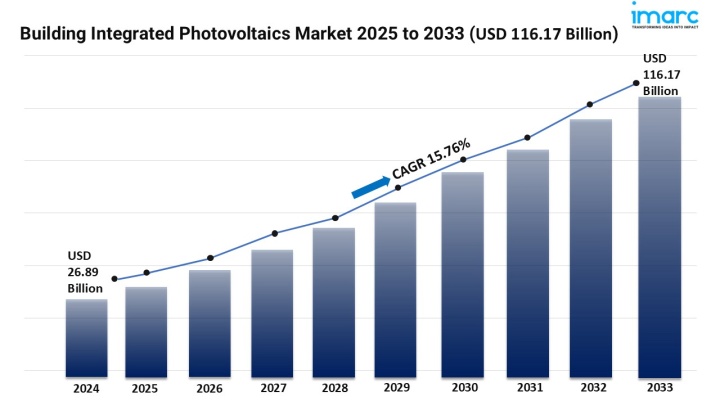

Market Overview:
The building integrated photovoltaics market is experiencing rapid growth, driven by sustainable construction demand, technological advancements, and smart city integration. According to IMARC Group's latest research publication, "Building Integrated Photovoltaics Market Size, Share, Trends and Forecast by Product Type, Application, End Use, and Region, 2025-2033", The global building integrated photovoltaics market size reached USD 26.89 Billion in 2024. Looking forward, IMARC Group expects the market to reach USD 116.17 Billion by 2033, exhibiting a growth rate (CAGR) of 15.76% during 2025-2033.
This detailed analysis primarily encompasses industry size, business trends, market share, key growth factors, and regional forecasts. The report offers a comprehensive overview and integrates research findings, market assessments, and data from different sources. It also includes pivotal market dynamics like drivers and challenges, while also highlighting growth opportunities, financial insights, technological improvements, emerging trends, and innovations. Besides this, the report provides regional market evaluation, along with a competitive landscape analysis.
Grab a sample PDF of this report: https://www.imarcgroup.com/building-integrated-photovoltaics-market/requestsample
Our report includes:
Growth Factors in the Building Integrated Photovoltaics Industry:
The global push for green building practices is driving BIPV adoption as developers seek low-carbon, energy-efficient solutions. Solar modules integrated into façades, windows, and canopies allow buildings to generate electricity while maintaining aesthetics. Policies like Germany’s nZEB incentives and California’s Title 24 regulations promote solar integration, while sustainability certifications such as LEED encourage eco-conscious design. Awareness campaigns and real estate marketing are spotlighting solar-enabled buildings to attract environmentally-minded consumers. Challenges remain in emerging markets due to high upfront costs and limited grid infrastructure. Nonetheless, growing interest in net-zero and carbon-neutral construction is steadily fueling the BIPV market worldwide.
Technological innovation is enhancing BIPV performance and versatility. Transparent perovskite solar films and flexible organic panels enable seamless integration into glass façades and skylights. Color-customizable and patterned PV modules allow architects to preserve design aesthetics while generating power. Thermal hybrid panels now combine electricity production with building heating or cooling, improving overall efficiency. Research is also advancing self-cleaning coatings and durable encapsulation to extend panel lifespan in extreme climates. These breakthroughs are gaining visibility at international trade shows and green technology expos. As materials become more efficient and visually adaptable, BIPV adoption is expected to rise in both residential and commercial sectors.
BIPV is becoming a central element of smart city energy strategies. Urban developments in cities like Singapore and Helsinki are integrating solar façades into transportation hubs, municipal buildings, and public spaces. IoT-enabled monitoring systems allow real-time tracking of energy generation and consumption, optimizing load management and supporting EV charging infrastructure. Smart city planning increasingly mandates on-site renewable generation, encouraging developers to adopt BIPV solutions early in project design. Regulatory inconsistencies, complex permitting, and varying grid capabilities in emerging economies slow implementation. Nevertheless, successful smart city deployments showcase the potential of BIPV to support sustainable urban energy ecosystems while improving building performance and public engagement.
Key Trends in the Building Integrated Photovoltaics Market:
BIPV adoption is accelerating through integration with advanced energy management platforms. AI-driven systems link solar output to lighting, HVAC, and battery storage, enabling predictive energy usage and carbon emission reduction. Smart dashboards allow facility managers to monitor performance remotely and optimize building operations dynamically. Some systems also incorporate automated shading, temperature control, and indoor environmental quality monitoring. While large commercial campuses in the U.S., Japan, and Europe are adopting full-suite solutions, smaller developers face cost barriers. The convergence of BIPV with smart building systems is enhancing sustainability metrics, operational efficiency, and occupant comfort, positioning integrated solar technologies as a cornerstone of energy-smart construction.
Vertical BIPV solutions are expanding in dense urban centers where rooftop space is limited. High-rise façades now integrate photovoltaic glass to generate power without compromising natural light or aesthetics. Modular panels, mirrored surfaces, and patterned designs allow architects to maintain visual appeal while producing electricity. Cities such as Hong Kong, Frankfurt, and Toronto are piloting these installations on commercial and residential skyscrapers. Heritage sites and restricted rooftops are driving creative vertical BIPV applications. Despite structural and mounting challenges, advances in lightweight panels and flexible frames are enabling scalable, high-performance vertical installations. Urban planners increasingly consider vertical solar integration for energy-positive building strategies.
Modular construction is increasingly leveraging factory-assembled BIPV components to reduce on-site labor and project timelines. Prefabricated solar façades, curtain walls, and roof panels ensure quality control, faster installation, and consistent energy output. Scandinavian and European developers are producing energy-positive prefab homes equipped with integrated PV modules and storage solutions. This approach is especially effective for schools, residential complexes, and commercial facilities with repetitive designs. Challenges include harmonizing prefabricated components with local grid regulations and interconnection standards. Collaborative planning among manufacturers, utilities, and developers is essential. Prefabricated BIPV solutions combine efficiency, scalability, and sustainability, driving widespread adoption in modern construction projects.
We explore the factors propelling the building integrated photovoltaics market growth, including technological advancements, consumer behaviors, and regulatory changes.
Leading Companies Operating in the Global Building Integrated Photovoltaics Industry:
Building Integrated Photovoltaics Market Report Segmentation:
By Product Type:
Polycrystalline represents the largest segment due to its cost-effectiveness compared to other types of solar cells, such as monocrystalline silicon.
By Application:
Roofs hold the biggest market share owing to the increasing construction of luxury residential and commercial buildings.
By End Use:
Commercial exhibits a clear dominance in the market as BIPV is ideally suited for office buildings, where it can be integrated into facades, roofs, and windows to generate electricity while maintaining aesthetic appeal.
Regional Insights:
Europe’s dominance in the building integrated photovoltaics market is attributed to investment in green building practices to reduce the carbon footprint of construction procedures.
Note: If you require specific details, data, or insights that are not currently included in the scope of this report, we are happy to accommodate your request. As part of our customization service, we will gather and provide the additional information you need, tailored to your specific requirements. Please let us know your exact needs, and we will ensure the report is updated accordingly to meet your expectations.
About Us:
IMARC Group is a global management consulting firm that helps the world’s most ambitious changemakers to create a lasting impact. The company provide a comprehensive suite of market entry and expansion services. IMARC offerings include thorough market assessment, feasibility studies, company incorporation assistance, factory setup support, regulatory approvals and licensing navigation, branding, marketing and sales strategies, competitive landscape and benchmarking analyses, pricing and cost research, and procurement research.
Contact Us:
IMARC Group
134 N 4th St. Brooklyn, NY 11249, USA
Email: sales@imarcgroup.com
Tel No:(D) +91 120 433 0800
United States: +1–201971–6302
